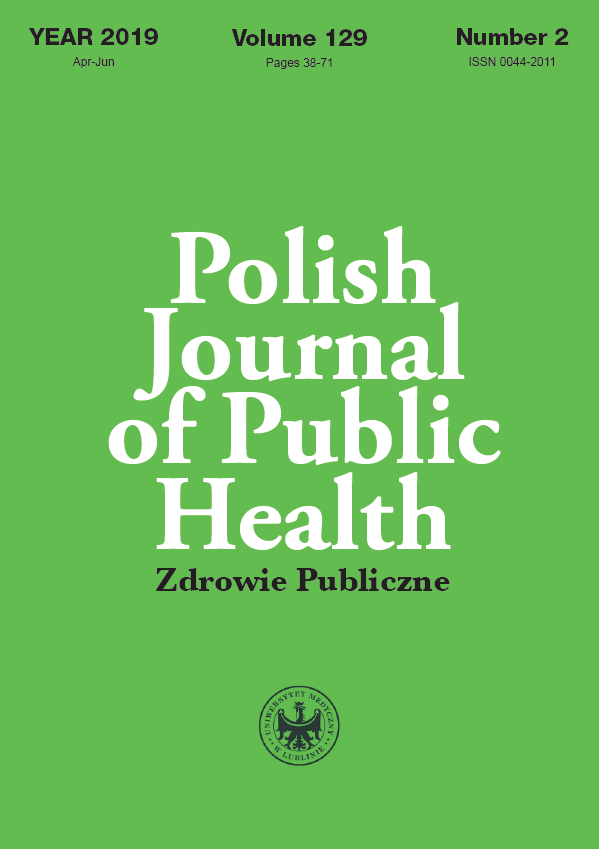Renal-cell carcinoma – novel concepts of classification
DOI:
https://doi.org/10.2478/pjph-2019-0014Keywords:
renal cell carcinoma, novel cancer classification, PRCC characteristicAbstract
Renal cancer, according to the Polish National Cancer Registry, was the cause of 4% of cancer cases in men and 3% of cases in women in 2010. Most often it affects men over 65, although it may also concern infants. In 2010, the number of reported cases for men was 2,700 and 1,900 for women. For the last three decades – up to 1990, the incidence of kidney cancer has increased significantly. Currently, it remains at the stable level of morbidity. One of the most significant issues of modern diagnostics and treatment of renal cancer is the problem of its heterogeneity brin-ging many difficulties in systematization and categorization of this neoplasm. The World Health Organization Classification of Renal Tumors has been published in 2004 and is currently supplemented with new classification units, which, according to ISUP (International Society of Urological Pathology), should be considered as separate groups of kidney epithelial cancers.
References
1. IACR Polish National Oncology Register.
2. Srigley JR, Delahunt B, Eble JN, et al. More. The International Society of Urological Pa-thology (ISUP) Vancouver Classification of Renal Neoplasia. Am J Surg Pathol. 2013;37(10):1469-89.
3. Rekha PR, Rajendiran S, Rao SI, et al. Histological reclassification, histochemical characterization and c-kit immunoexpression in renal cell carcinoma. Indian J Urol. 2008;343-47.
4. Delahunt B, Eble JN. History of the development of the classification of renal cell neoplasia. Clin Lab Med. 2005;25:231-46.
5. Allory Y, Ouazana D, Boucher E, et al. Papillary renal cell carcinoma. Prognostic value of morphological subtypes in clinicopathologic study of 43 cases. Virchows Arch. 200 3;442:336-42.
6. Eble JN, Togashi K, Pisani P, et al. Renal cell carcinoma. In: J. N. Eble, G. Sauter, J. I. Epstein, I. A. Sesterhenn (ed). Pathology and genetics of human tumours of the urinary and male genital organs. Lyon: IARC Press; 2004. p. 12-4.
7. Polascic TJ, Bostwick DG, Cairns P. Molecular genetics and histopathologic features of adult distal nephron tumors. Urology. 2002;60:941-6.
8. Srigley JR, Eble JN. Collecting duct carcinoma of kidney. Semin Diagn Pathol. 1998;15:54-67.
9. Swartz MA, Karth J, Schneider DT, et al. Renal medullary carcinoma: clinical, pathologic, immunohistochemical, and genetic analysis with pathogenetic implications. Urology. 2002;60:1083-9.
10. Beuselinck B, Lerut E, Wolter P, et al. Sarcomatoid dedifferentiation in metastatic clear cell renal cell carcinoma and outcome on treatment with anti-vascular endothelial growth factor receptor tyrosine kinase inhibitors: a retrospective analysis. Clin Genitourin Canc. 2014;12(5):e205-e214.
11. Moses KA, DeCaro JJ,Osunkoya AO, et al. Tubulocystic carcinoma of the kidney: a case report of natural history and long term follow-up. Scientific World J. 2010;10:586-9.
12. Sule N, Yakupoglu U, Shen SS, et al. Calcium oxalate deposition in renal cell carcinoma associated with acquired cystic kidney disease-associated carcinoma. Am J Surg Pathol. 2012;20:19-28.
13. Kuroda N, Tamura M, Hamaguchi N, et al. Acquired cystic disease-associated renal cell carcinoma with sarcomatoid change and rhabdoid features. Ann Diagn Pathol. 2011;15:462-6.
14. Gobbo S, Eble JN, Grignon DJ, et al. Clear cell papillary renal cell carcinoma: a distinct histopathologic and molecular genetic entity. Am J Surg Pathol. 2008;32:1239-45.
15. Argani P, Lal P, Hutchinson B, et al. Aberrant nuclear immunoreactivity for TFE3 in neoplasms withTFE3 gene fusions: A sensitive and specific immunohistochemical assay. Am J Surg Pathol. 2003;27:750-61.
16. Komai Y, Fujiwara M, Fujii Y, et al. Adult Xp11 translocation renal cel carcinoma diagnosed by cytogenetics and immunohistochemistry. Clin Cancer Res. 2009;15:1170-6.
17. Smith N, Illei P, Gonzales N, et al. Renal cell carcinoma (RCC): report of six new genetically-confirmed cases and expanded Immunohistochemical (IHC) profile. Mod Pathol. 2013;26 (S2):250A.
18. Hewett-Emmett D, Tashian RE. Functional diversity, conservation, and convergence in the evolution of the alpha-, beta-, and gamma-carbonic anhydrase gene families. Mol Phylogenet Evol. 1996;5(1):50-77.
19. Immunohistology of prostate, bladder, testis and kidney. In: D. Dabbs (ed). Diagnostic immunohistochemistry. Philadelphia: Churchill Livingstone; 2006.
20. Zhou M, Roma A, Magi-Galluzzi C. The usefulness of immunohistochemical markers in the differential diagnosis of renal cell neoplasms. Clin Lab Med. 2005;25:247-57.
Downloads
Published
Issue
Section
License
Copyright (c) 2019 Polish Journal of Public Health

This work is licensed under a Creative Commons Attribution-NonCommercial-NoDerivatives 3.0 Unported License.


